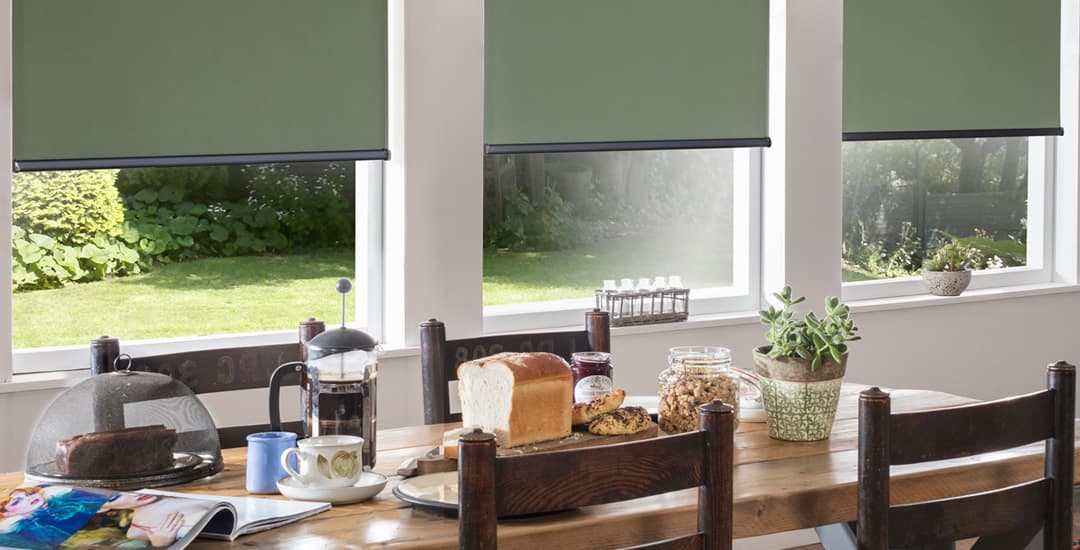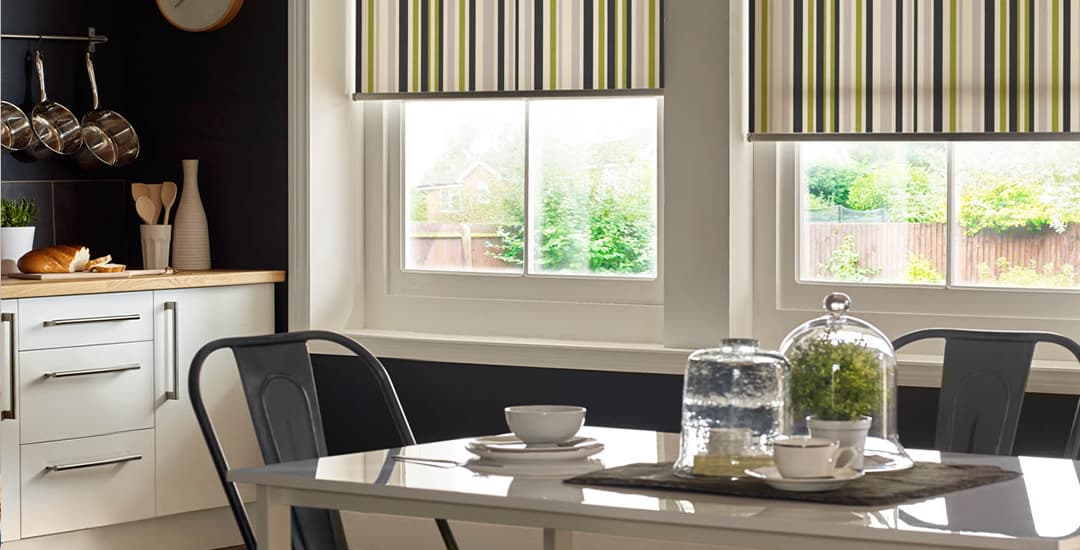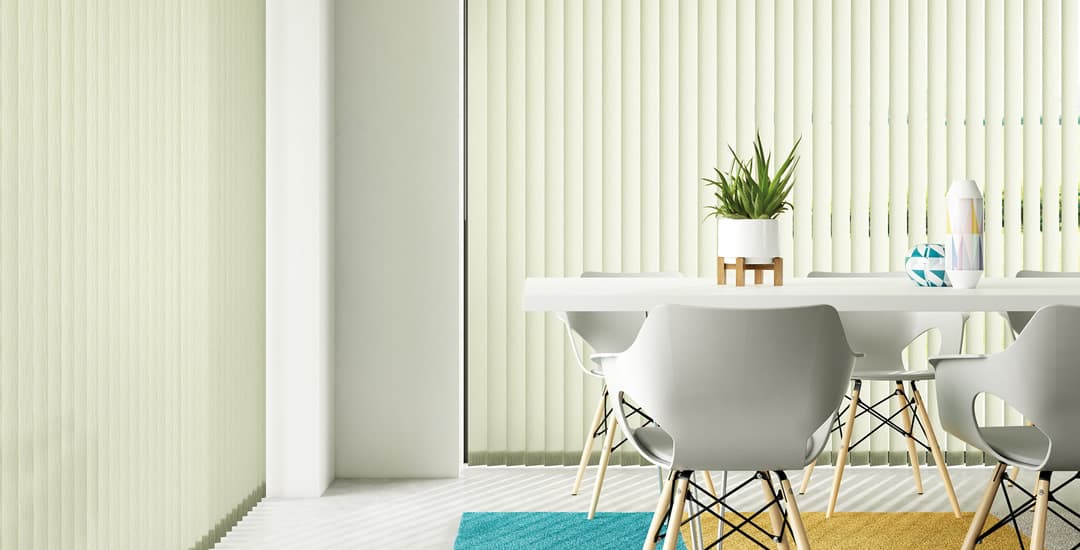
Pinning down what blinds are best for the dining room depends greatly on the dining room in question. Really there is no one uniting factor that applies to dining rooms in the same way that there is for most other rooms; dining rooms (should you have one at all) can be one of the most variable spaces in the home.
Some dining rooms are essentially an add-on or adjunct to the kitchen, others segue off a living room, some are their own separate space that may be some way from the kitchen, and others might see more service as a homework table or the place to let children spread out craft projects than for eating at!
Each of these different dining room types and potentially, usage applications has implications for making the right choice of dining room blinds… Plus, if your dining room has a potential plot twist in the form of a very large or wide window (or more commonly, patio doors) the waters get even murkier.
This means that there is no one size fits all type of blind that works or is the best bet for every dining room in the country; but different types of dining rooms naturally have certain types of blinds that are a better pick for them than others.
This blog post will cover what blinds are best for dining rooms of different types, so choose the scenarios that apply to yours and proceed accordingly.
Contents:
- 1. What blinds are best for a standalone dining room with regular windows?
- 2. What blinds are best for dining rooms that adjoin or open onto a kitchen?
- 3. What blinds are best for dining rooms that are connected to a living room?
- 4. What blinds are best for dining rooms with patio doors?
- 5. What blinds are best for dining rooms that double as a home office or homework table?
- 6. What blinds are best for dining rooms that don’t see a lot of use?
- 7. What are the best dining room blinds for… Something else?
1. What blinds are best for a standalone dining room with regular windows?
If your dining room is a room all of its own and its windows aren’t overly large, tall, or odd, any style and design of blind you like is theoretically an option.
There are a number of options for what a blind does and how it looks that you need to factor in when narrowing down your selection from there.
- Your functional choices can most succinctly be summarised in terms of whether you want your blinds to filter light and offer you options for protecting your privacy without blocking your own view out, or if that’s not really a concern.
- If you do want to be able to fine-tune the light filtering and privacy with your blinds, this means choosing Venetian, wood, faux-wood, vertical, or day and night blinds. If you’re not overly concerned on this front, Roman blinds and roller blinds are options too.
- Style-wise, the various different types of window blinds collectively cover literally every base in terms of the type of finish you want to achieve; some being a better fit perhaps for modern or minimalistic dining rooms, and others creating a more classical, traditional, or warm finish.
- Also, colour and in some cases, pattern options across ranges of blinds can be extensive, with roller blinds offering perhaps the most comprehensive and diverse range of options in this respect.
- Roman blinds can look very opulent and luxurious, which is a great fit for a formal dining room; and day and night blinds, for example, style well in a modern dining room.
- Wood or faux-wood blinds and Venetian blinds are fairly diverse in terms of the dining room styles they will suit.
- Vertical blinds are something of a diamond in the rough here too. While often overlooked or quickly disregarded when it comes to choosing blinds for domestic windows, vertical blinds can create a very polished and pleasing appearance when styled to match the dining room in question.
2. What blinds are best for dining rooms that adjoin or open onto a kitchen?

Some dining rooms either adjoin a kitchen directly, have a serving hatch between the two, or are literally just one end of a larger kitchen being classed as a dining room by virtue of housing a table and chairs.
So, what blinds are best for a dining room that adjoins a kitchen, and why? There are two factors to take into account here.
The first is whether or not humidity, airborne fats, food odours, and even water from the kitchen will ever make its way into the dining room. The humidity from the kitchen in particular may well be a factor for most dining rooms that are part of a kitchen or open onto one, and many that have a serving hatch too.
If this does hold true for your own dining room, then you’re advised to choose waterproof blinds, as those made of absorbent fabrics will suffer in short order.
This means that your dining room blind choices can safely be made from among the ranks of:
- Faux-wood blinds.
- Venetian blinds.
- Roller blinds made of PVC or vinyl fabrics specifically.
- Vertical blinds made of PVC or vinyl fabrics specifically.
Unless your kitchen-related dining room never really gets any humidity, condensation, cooking smells, or moisture in it, you will want to steer clear of Roman blinds, real wood blinds, and either roller or vertical blinds that are made of polyester, as none of these are waterproof.
Also, you will need to have a think about whether you want your kitchen-adjoining dining room blinds to match those in the kitchen and so, continue the theme; or deliberately contrast with them in support of creating more of an impression of two separately defined spaces or open-plan rooms.
3. What blinds are best for dining rooms that are connected to a living room?
If your dining room is connected to your living room, is one end of your living room, or is otherwise kind of closely associated with that space, you don’t have to factor in any specific challenges in the same way that you would if you were dealing with the dining room/kitchen combo above.
The only real question in terms of your blind choices are whether you want them to match the living room blinds or contrast with them, to either blend the spaces or define them as separate areas respectively.
4. What blinds are best for dining rooms with patio doors?

If your dining room has patio doors or any other type of very large, tall, or wide window, your choice of suitable blinds may be moderately limited.
The size/length that blinds can be made in tops out at a point; but where this point falls can be different for different types of blinds. The factors that dictate it include not just the physical challenges of making (and shipping) a gigantic blind, but also the potential weight of it.
Huge blinds made of heavier materials could absolutely bring down a not-so-robust wall and flatten anyone beneath it; should you and your hench mates manage to heft it into position to install it at all.
Additionally, a blind that’s on the chonk side of the weight spectrum would also be hard work to operate in terms of the strength required to adjust it.
What’s in and what’s out then if you need blinds for a dining room with patio doors?
- You probably wouldn’t want to pick (or would not be able to find offered) wooden blinds, faux-wood blinds, or Roman blinds in a size that will cover the whole door array in one unit.
- However, if you were willing to buy two separate matching blinds to cover your patio doors rather than one huge blind, Roman blinds could be back on the table.
- Roller blinds can generally be made in patio door-type sizes as they’re not overly heavy. They’re also a very economical way to cover a large window.
- Day and night blinds can generally be made to fit dining room patio doors in one piece too.
- Vertical blinds are perhaps the most widely chosen option for dining room patio doors, and tend to be the most cost-effective blinds for large windows too.
- Venetian blinds (the type made of aluminium) are a potential option for regular sized patio doors, given that aluminium is light. It is perhaps more common though if choosing Venetian blinds for patio doors, to buy two and hang them side by side.
- You might also want to consider picking blinds that incorporate thermally insulating linings, to help to reduce the impact of heat loss from very large windows.
- Don’t forget that if your dining room patio doors are also all part of one room with your kitchen or adjoin or open onto the kitchen, you will probably need to take into account the considerations covered earlier regarding the presence of humidity as well.
If you’d like some more general info on choosing blinds for tall or generally large windows, check out this post too.
5. What blinds are best for dining rooms that double as a home office or homework table?
A.K.A, “When is a dining room not a dining room?”
- If your dining room table is also a workspace or somewhere the kids do their homework or otherwise spread things out for purposes other than eating them, you might want to think about blinds that can filter light and take the edge off potential screen glare.
- Blinds that can be used to filter light include day and night blinds, Venetian blinds, vertical blinds, faux-wood blinds, and wooden blinds.
- If your children do crafts, painting, or anything mess or water-related at the dining room table and there’s a middling chance that this is going to end up coming into contact with your blinds, circle back to the considerations I mentioned for dining rooms that adjoin kitchens to select appropriately waterproof and easy-to-clean options.
6. What blinds are best for dining rooms that don’t see a lot of use?
Finally, if your dining room is largely ornamental or reserved for high days and holidays, there are a couple of points to note that may influence what blinds are best for dining rooms that are not used very often.
- For dining rooms that tend to get chilly due to lack of use, thermally insulating blinds are a good pick. These can be found within ranges of roller blinds, Roman blinds, and vertical blinds just for starters.
- If your dining room gets at all damp or condensated because it’s not used much, aired very often, or heated, you may want to look again at the blinds I mentioned as being suitable for kitchens, as these are waterproof and won’t suffer from extended exposure to damp or condensation.
- One thing to note is that if you aren’t using your dining room much, this may also mean that you will tend to leave the blinds in there in the same position for protracted periods of time too.
- If this is not the case and you open or close the blinds or otherwise adjust them regularly, this won’t matter; but otherwise, I do advise that you open and close the blinds at least once a week to ensure that they continue to operate smoothly, and don’t fur up with dust. This latter happens most acutely in the folds of Roman blinds that aren’t operated for weeks on end.
- Dusting your dining room blinds as part of your regular household cleaning routine (even if you don’t use the dining room much) actually helps to lengthen their lifespan, and reduces the chances of their mechanisms getting clogged with dirt and affecting how well they function.
- It also reduces the frequency at which you’d need to give them a more comprehensive cleaning too!
7. What are the best dining room blinds for… Something else?
If your dining room has a challenge or potential factor that I’ve missed and you’re not sure how to handle (and I do always enjoy a blinds-related surprise or chance to learn something new) please leave me a comment or email me directly and I’ll try to help.




